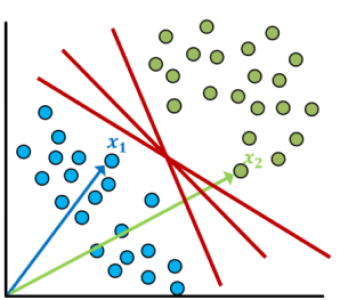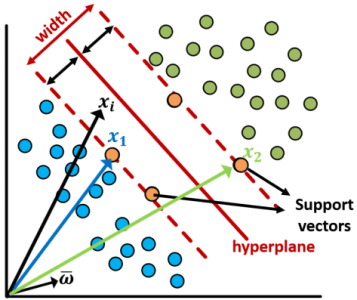...
The SVM algorithm will train the model based on the training set and test it on new entities from the test dataset. The algorithm constructs optimal hyperplanes (linear or nonlinear) that best separates the two considered classes (Accepted and Rejected). This is illustrated in Figure 2, which shows a pictorial example of two data sets that can be separable into two classes, here linear boundaries. SVM approaches this problem through an optimization problem which minimize the distance between the decision boundaries and any of the data entities.
a) Separating hyperplanes | b) Best hyperplane |
Fig 2 - An overview sketch of Support Vector Machine algorithm linear classifier [Savas, 2019] | |
...
Supposing that several predictors were trained with a minimum accuracy of 80%. Then, we could create a better classifier by aggregating, for each new entity, the predictions of all classifiers and predict the class that is obtaining most of the votes. This is illustrated in Figure 3, for an ensemble classifier, combining the results of four predictors. Considering a new instance, 3 classifiers predicted ‘1’, while the other one predicted ‘0’, thus the ensemble classifier will predict ‘1’. The voting classifier can deal with label predictions (as seen in Figure 3) - and it is called a hard voting classifier, or with probability predictions and we deal with a soft voting (we will predict the class with the highest class probability, averaged over all the individual predictors.
Fig 3 - Predictions of a hard voting classifier [Géron, 2019] |
...
Deep Learning (DL) techniques are the most modern technologies used to classify data in different multidisciplinary domains. They are a subset of machine learning techniques that achieves good performance and flexibility by learning to represent the data as nested hierarchy and concepts within layers of the neural network. Deep learning algorithms have been proven to outperform traditional machine learning as the scale of data increases, as illustrated in Figure 5 [Chalapathy, 2019; Javaid, 2016; Peng, 2015].
Fig 5 - Performance comparison of Deep learning-based algorithm versus traditional Machine Learning algorithms [Bahnsen, 2016; Chalapathy, 2019] |
...







